GATEKEEPERS TO LIQUIDITY.
E/OMS providers need to overcome political hurdles to help the buy side navigate credit’s fractured markets. Anna Reitman investigates.
Vendors and brokers that bundle order routing and matching together, while restricting access to competitors, appear to have a considerable, potentially anti-competitive, advantage. Yet paradoxically, by restricting the flow of orders based on their own interests, they are disadvantaging their customers.
Alfred Eskandar, CEO of execution management system (EMS) provider Portware, noted that not all industry participants may have quite the same priorities.
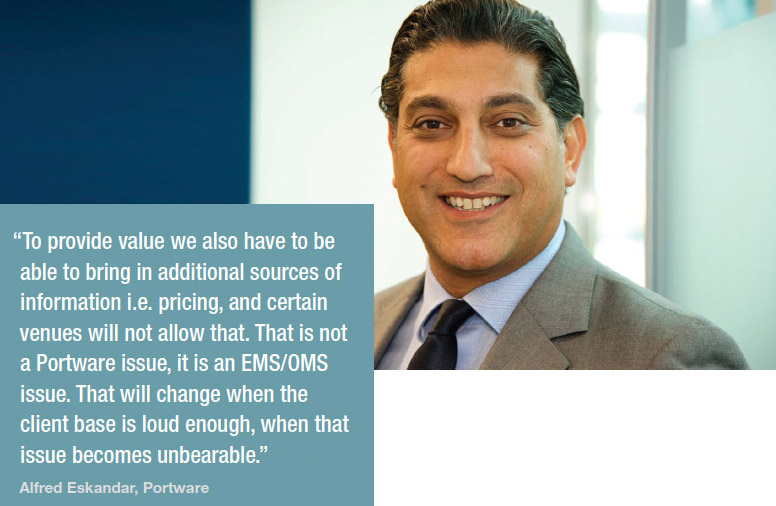
“Portware can handle any asset class in staging and routing. To provide value we also have to be able to bring in additional sources of information i.e. pricing, and certain venues will not allow that. That is not a Portware issue, it is an EMS/OMS issue,” he says. “That will change when the client base is loud enough, when that issue becomes unbearable.”
John Greenan, a front-office trading technology consultant for Alignment Systems, said that the challenges need to be properly understood: “The sooner people realise that the issue is economics and not technology the sooner the industry as a whole can make progress, and that means people working in joint ventures and partnerships.”
For traders selecting execution/order management systems (E/OMSs), knowing that they can reach fixed income trading liquidity is imperative. As bond trading moves from voice-brokered to electronic, the buy side has never had so many options for routing orders. At the same time, technological advances are being implemented at a pace that limits the effect of this fragmentation despite a vicious cycle of venue proliferation in the corporate bond space.
Richard Hooke, buy-side product director at Fidessa, says, “In terms of searching to get a deal done as a buy-side trader, you obviously can’t look at all 100+ venues, so you have to pick and choose.”
The amount of fixed income venues popping up, he added, is “unfeasible”. All of them are trying to solve a fundamental liquidity question: how do you find the other side of the trade in a post-financial crisis environment – one in which the sell side’s ability to use balance sheet to help the trading process has largely disappeared.
Active investment in technology
According to one industry commentator, the current state of the E/OMS provider world can be summed up as: companies that are losing business, and BlackRock’s Aladdin, which is winning the business. Schroders, for example, is one of the latest asset managers to make the move, putting aside a Charles River front end to select Aladdin (Schroders was not able to arrange comment in time for publication).
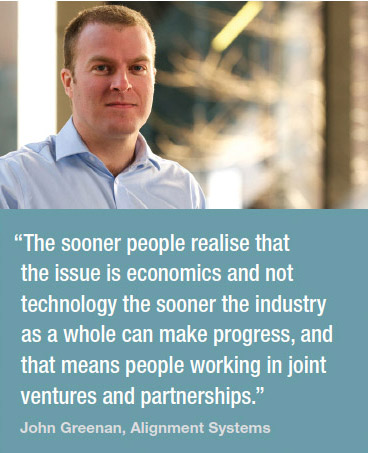
The reason so many relationships break down, the source added, is that the buy side does not want to pay enough money for technologists who understand the market and so end up with inadequate contracts to cover all the work needed.
From a vendor’s point of view, many buy side firms have become used to having execution systems as a service, meaning they lack the resources to manage the systems themselves. Enrico Melchioni, managing director at IT and services provider LIST, says, “Many are not really ready to invest money into these kinds of systems. I think is the biggest challenge they are facing.”
But there is also the business model of E/OMS providers who can struggle to make revenues in a way that supports the customer. Buying an OMS means agreeing to a defined set of acceptance criteria for delivery of the system, but if there is one extra item then it becomes a material change, which comes along with a hefty bill.
“You’ve got vendors whose economic model doesn’t work very well, because they are moving from a site-deployed license fee plus extra services model to a software as a service model,” said one source. “None of the software we are discussing here is complicated to write, it’s all around getting the economic models right.”
LIST’s Melchioni says that now, the point is to understand whether large buy side firms will actually provide service to smaller firms, or whether in general the buy side will start building a more complex execution desk with pricing and advanced EMS systems to make prices.
“The traditional buy-side trader doesn’t have in his DNA the idea of becoming a price maker or being an active liquidity provider,” he says “Possibly, the buy side will need to hire people from sell-side institutions to do that.”
Keys and gates
Even if the relationship and support network around a trading system are adequate, the interface for connection between a venue and trading system is still a bone of contention. There is no obligation for markets to provide open interfaces or for E/OMS providers to choose to connect to new venues, giving those with longer standing relationships, forged in an age of less diversity, an advantage.
Fidessa’s buy-side platform connects to major established players for fixed income – Tradeweb, MarketAxess, Bloomberg, and Liquidnet – driven by demand from the large tier-one customers, says Hooke. However on a regular basis there is also connectivity to new fixed income venues, as “selected by the buy-side community,” he notes.
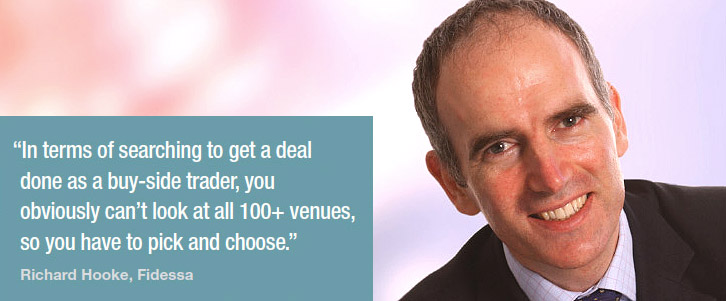
The firm is also working with Project Neptune, an industry consortium aiming to create a connectivity network. Here, the structure is a different animal than trading via an exchange-like mechanism, Hooke explained.
“It’s receiving information about who is advertising inventory available of a particular bond,” he says. “We can display that information against the orders that buy-side fixed income traders are looking at to give an indication that there’s some information out there that is potentially useful in terms of the execution strategy of those bonds.”
Using Bloomberg typically means using Bloomberg’s bespoke terminal. And though there have been moves to release new protocols to support interaction, “it is not an easy beast to deal with, in general,” notes one observer.
Melchioni said that there is normalisation work needed to provide a unique interface to multiple trading venues.
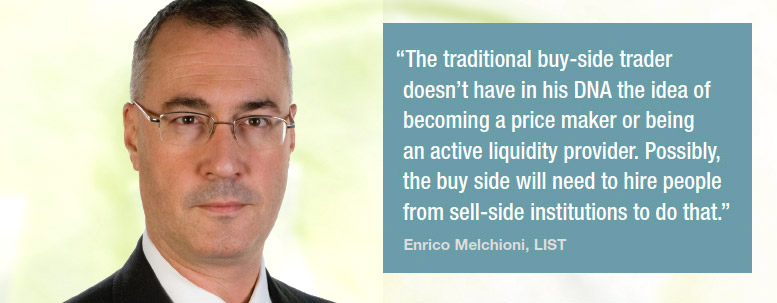
“Some venues are more open to this process, others are resisting integration, for example forcing the buy side to connect only through a graphical user interface that requires manual intervention. Not all relevant venues provide API’s, but there seems to be a change in this direction.”
API panacea?
Interacting with a venue through an API means a simpler user experience, noted Fidessa’s Hooke, but it is down to the willingness of the different venues in the space to actually offer it. Moreover, to be really useful, it needs to be consistent. That consistency is unlikely given that venues vie for position to sell their USPs, which translates to different styles of market interaction.
“Having a single API to an open API to deal with that different type of flow, or that different type of interaction would be quite challenging”, said Hooke.
TradingScreen, a provider of E/OMS technology recently deployed the TradeExchange product to underpin SGX’s Bond Pro platform and in September 2016 launched its own TradeCross venue in Europe.
Joe Ahearn, co-founder and COO of TradingScreen, says the firm’s FIX API for fixed income supports the multiple protocols including auction, crossing, negotiations, firm and indicative request for quote, countering and request for stream. He expects this will continue to evolve with clients’ needs.
Hooke says there are not as many different styles of trading as there are venues, he noted, adding that Fidessa is interested in using the APIs more. “We think that helps the trader stay within an environment that is embedded, which is their OMS, rather than having lots of disparate systems that they have to interact with,” he says.
Companies like FlexTrade are pushing forward with an open API for fixed income, but the firm declined to comment on developments at this time.
Meanwhile, the industry is on wait-and-see mode over how regulatory decision-making might influence market structure development.
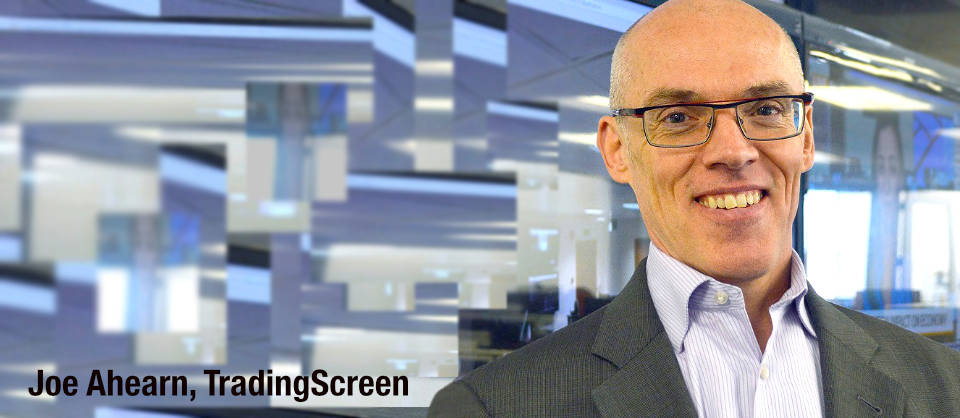
Ahearn says: “Fixed income will take a path similar to the national-best-bid-offer, where best execution will require that all orders be shown to different platforms.”
Hooke adds, “[In this asset class it] is really about trying to make sense of this sort of huge plethora of information and systems. I think that’s where a lot of the energy is going in terms of systems work.”
©TheDESK 2016
©Markets Media Europe 2025












